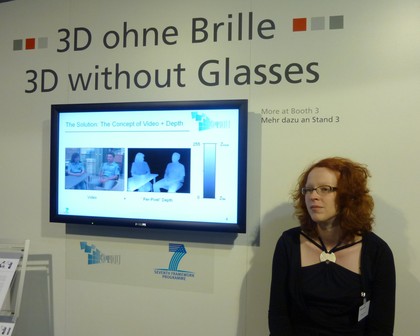Glasses-free 3D: when will it be in our homes?

The race is on to bring glasses-free 3D to a high street near you. Using a variation of the displays seen on next-generation 3D mobiles like LG's Optimus 3D, so-called autostereoscopic (or auto-3D) screens promise to free us from the tyranny of bespectacled 3D forever.
But with manufacturers still embroiled in rows over current Active Shutter and Passive 3D goggles, just how long will we have to wait - and will it be worth it in the end?
The brand most likely to make auto-3D to commercial reality is Toshiba. It was the first to sell glasses-free 3D TVs to consumers, shipping screens into its home market last December. These GL (Glasses Less) models came in 12 and 20-inch screen sizes. Since then it has shown prototypes up to 65 inches at various technology expos and events around the world.

DUE DATE: Every major TV brand wants to introduce glasses-free 3D at some point. The only question is when?
The TV specialist behind the launch was Hideo Kezuka. He says the sets were the culmination of more than five years worth of research and development. Toshiba unveiled its first autostereoscopic product back in April 2005, but it wasn't a TV. It was actually a flatbed visual display. At the time boffins felt 3D could be used for commercial applications, games and even virtual menus.
So how does auto-3D work?
Auto-3D TVs are basically displays offering multiple depth views. Each eye sees a different depth, which creates the stereoscopic image. There are several techniques which make multi-view possible, but the two best known are parallax barrier (developed by Sharp and used on the Nintendo 3DS) and lenticular lenses (commonly used to create 3D prints). The former is the route mainstream auto-3D screens will go.
A parallax barrier typically sits onto top of an LCD panel. It has slits which steer each eye to a different image. In a simple, single view parallax barrier display, the resolution of the original image is halved to create the stereoscopic picture. The technology works well for a single viewer in a fixed position. However, a multi-view parallax barrier significantly reduces resolution.
Sign up for breaking news, reviews, opinion, top tech deals, and more.
"Basically, creating a wide viewing angle and generating multiple parallax views results in the loss of effective image resolution,' explains Hideo Kezuka. He says Toshiba's first 20in auto-3D set used a high-resolution panel to create an image resolution akin to a 720p TV, at "1280 x720 pixels per view."

CHALLENGES TO FACE: Toshiba TV specialist Hideo Kezuka says the challenge with autostereoscopic TVs is to maintain resolution and viewing angle
For large screen auto-3D, TV manufacturers will need to use 4K2K screens; these offer four times the resolution of today's Full HD 2D TVs. Of course, deriving nine parallax images from such a screen will drag down the subjective resolution of the screen to below Full HD.
But it's not just about the panel. Toshiba also had to develop multi-parallax conversion LSIs able to dynamically interpolate nine layers of depth from the original source. This arithmetic task requires Herculean silicon.
Enter Toshiba's CEVO Engine picture processing technology. Derived from the Cell Broadband processor which empowers the PS3, this seven-core processor brings unprecedented computing power to the TV market. With an integrated high-speed DRAM capable of handling 9.6 gigabits of data it holds the key to Toshiba's glasses free ambitions, easily being able to calculate the 8 or 9 views required for a large screen TV on the fly.
While specifics are still under wraps, it's thought that the brand's next auto-3D panel will feature an active LCD layer which can be switched off for flat viewing, allowing viewers to see a 2k image upscaled to 4K.

LENTICULAR 3D: One alternative to parallax barrier 3D TV is lenticular lenses, however they seem better suited for commercial displays
Clearly for auto-3D TVs to take off, they need to offer image quality that at least approaches what we have now. However, we've seen scant evidence that auto-3D will be good enough to compete with existing 3D-with-glasses screens anytime soon. But the tech continues to have high profile support.
3D thought-leader James Cameron is confident that it will eventually change the face of entertainment: "Once we get past the last threshold, which is autostereoscopic displays, then I think 3D is going to be the way we watch all our media – in the movie theatres and at home," he says. Cameron predicts that auto-3D will become commonplace within "eight to ten years."
When can you buy a glasses-free 3D TV?
Although auto-3D prototypes seen to date have looked distinctly rough, breakthroughs happen quickly when there's a commercial imperative. Toshiba has pledged to launch a large auto-3D screen in Europe before the end of its current financial year.
Other brands are in hot pursuit. This year's IFA 2011 tech expo (which runs in Berlin September 2-7) is likely to see a rash of competing announcements. Front runner amongst other brands is LG; the company has made it clear that it intends to take a lead in all things 3D.
If you're looking to browse a choice of glasses-free TVs on your high-street, 2013-2014 seems as good a time frame as any to plan for. That gives you plenty of time to start saving. After all, at least one thing is certain: they're unlikely to be cheap.

Steve has been writing about AV and home cinema since the dawn of time, or more accurately, since the glory days of VHS and Betamax. He has strong opinions on the latest TV technology, Hi-Fi and Blu-ray/media players, and likes nothing better than to crank up his ludicrously powerful home theatre system to binge-watch TV shows.